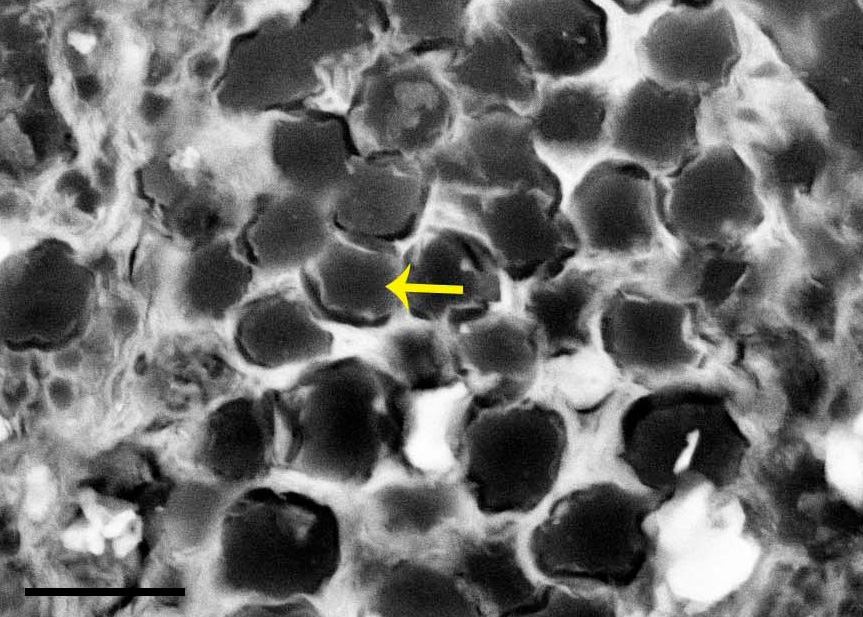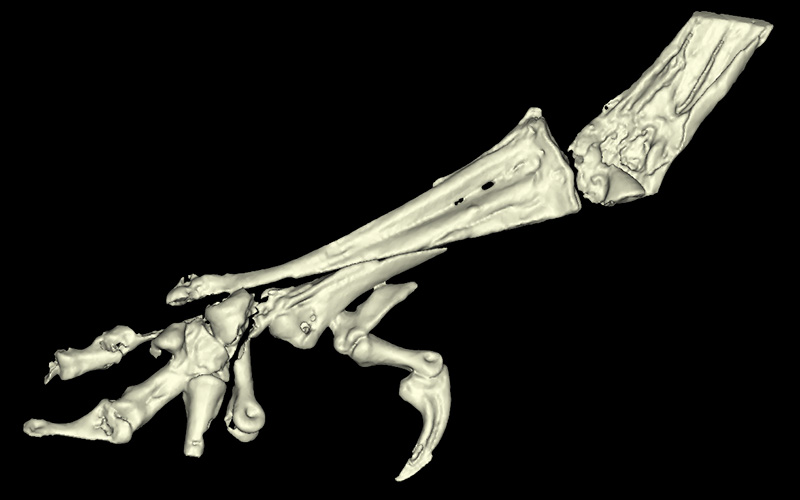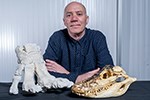Ground-breaking fossilised tissue reveals the gradual evolution of crouched legs in birds
Living birds have a more crouched leg posture compared to their dinosaurian ancestors, which generally are thought to have moved with straighter limbs (similar to the postures of humans).
A joint study by researchers from the UK and China, published in the online journal Nature Communications, illuminates how birds shifted toward this more crouched posture. The research team was led by Professor John R. Hutchinson at the Royal Veterinary College (UK) and Professor Baoyu Jiang at Nanjing University in China.
The team studied the lower leg of the early Cretaceous (about 125 million years old) bird Confuciusornis that had been fossilised in volcanic ash and lake sediments in China. Dr. Jiang said, “We found that this fossil had amazingly well preserved soft tissues around the ankle joint, including cartilages and ligaments. These soft tissues were not just preserved as an ashen replacement of the former tissue, as sometimes happens. Rather, the cellular and fibrous structure of the tissues was preserved at a microscopic level.”

Going beyond microscopic analysis, X-ray synchrotron and multiple spectroscopic imaging methods showed that the detailed anatomical preservation extended to the molecular level, with some of the original chemistry of the bird’s tissues remaining. In particular, the team found evidence of fragments of the collagen proteins that made up the leg ligaments, which matched the preservation at the microscopic tissue level of detail. Their findings concur with an expanding body of evidence that, under special conditions, some biological molecules including even amino acids or partial proteins, can persist over millions of years in the fossil record.
Professor Roy Wogelius from the University of Manchester, one of the collaborators on the project, commented that “the preservation in this fossil was exceptional and allowed us to resolve subtle but important chemical and structural details within this critical early species of bird.”
The researchers then reconsidered this evidence in light of the whole anatomy of the Confuciusornis leg, and that of its cousins from earlier dinosaurs to extinct and even modern birds.
Professor Hutchinson said, “Once we were confident that some of the remnants of the soft tissues around the ankle joint still remained around the ankle, we could reconstruct parts of the ankle beyond just the bones. The new information we gained about the anatomy of the cartilages and tendons show that this early bird had an ankle whose form fit an intermediate function between that of early dinosaurs and modern birds. Overall this reinforced other lines of evidence that the more crouched, zigzag limb posture of birds evolved gradually from early dinosaurs to birds, with even these early birds having limbs that were built and worked differently from those of living birds, but were approaching the modern condition.”

This many-layered study was enabled by international collaboration between many scientists from fields as diverse as palaeontology and ornithology, biomechanics, geology and geochemistry, medical imaging and physics. Professor Michael Benton at the University of Bristol added, “Our study exemplifies how a combination of sophisticated technologies with fast-paced discoveries of spectacular fossils is revealing new insights into how major changes in anatomy, physiology and behaviour evolved in animals.”
The research was funded by the National Science Foundation of China, Leverhulme Trust and Natural Environment Research Council (UK). It was published in the academic journal Nature Communications on the 22nd March 2017.
Press Office Contact
Uche Graves / Zoe White
T: 0800 368 9520
E: uche.graves@plmr.co.uk / zoe.white@plmr.co.uk
Notes to Editors
The Royal Veterinary College (RVC) is the UK's largest and longest established independent veterinary school and is a constituent College of the University of London. The RVC offers undergraduate, postgraduate and CPD programmes in veterinary medicine, veterinary nursing and biological sciences, being ranked in the top 10 universities nationally for biosciences degrees. It is currently the only veterinary school in the world to hold full accreditation from AVMA, EAEVE, RCVS and AVBC.
A research-led institution, in the most recent Research Excellence Framework (REF2014) the RVC maintained its position as the top HEFCE funded veterinary focused research institution.
The RVC also provides animal owners and the veterinary profession with access to expert veterinary care and advice through its teaching hospitals; the Beaumont Sainsbury Animal Hospital in central London, the Queen Mother Hospital for Animals (Europe's largest small animal referral centre), the Equine Referral Hospital, and the Farm Animal Clinical Centre located at the Hertfordshire campus.
RVC Press Release 22 March 2017
See other Press Releases.
You may also be interested in:
-
RVC’s Professor John Hutchinson elected Fellow of prestigious Royal Society
John Hutchinson, Professor of Evolutionary Biomechanics at the Royal Veterinary College (RVC), has …

